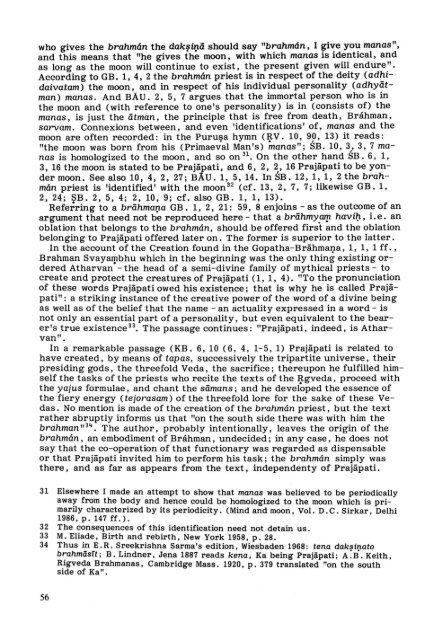Prajapati's relations with Brahman, Brhaspati and Brahma - DWC
Prajapati's relations with Brahman, Brhaspati and Brahma - DWC
Prajapati's relations with Brahman, Brhaspati and Brahma - DWC
You also want an ePaper? Increase the reach of your titles
YUMPU automatically turns print PDFs into web optimized ePapers that Google loves.
who gives the brahmán the dak{Ji~ä should say "brahmán, I ~i~e yo~ manas",<br />
<strong>and</strong> this means that "he gives the moon, <strong>with</strong> which manas IS ldentlcal, <strong>and</strong><br />
as long as the moon will continue to exist, the present given will endure" .<br />
According to GB. 1, 4, 2 the brahmán priest is in respect of the deity (adhidaivatam)<br />
the moon, <strong>and</strong> in respect of his individual personality (adhyätman)<br />
manas. And BAu. 2, 5, 7 argues that the immortal person who is in<br />
the moon <strong>and</strong> (<strong>with</strong> reference to one's personality) is in (consists of) the<br />
manas, is just the ätman, the principle that is free from death, Bráhman,<br />
sarvam. Connexions between, <strong>and</strong> even 'identifications ' of, manas <strong>and</strong> the<br />
moon are often recorded: in the Puru!?a hymn (~V. 10, 90, 13) it reads:<br />
"the moon was born from his (Primaeval Man's) manas"; SB. 10, 3, 3, 7 manas<br />
is homologized to the moon, <strong>and</strong> so on 31. On the other h<strong>and</strong> SB. 6, 1,<br />
3, 16 the moon is stated to be Prajäpati, <strong>and</strong> 6, 2, 2" 16 Prajäpati to be yonder<br />
moon. See also 10, 4, 2, 27; BÄU. 1, 5, 14. In SB. 12, 1, 1, 2 the brahmán<br />
priest is 'identified I <strong>with</strong> the moon 32 (cf. 13, 2, 7, 7; likewise G B. 1,<br />
2,24; SB. 2, 5, 4; 2, 10, 9; cf. also GB. 1, 1, 13).<br />
Referring to a brähma~a GB. 1, 2, 21: 59, 8 enjoins - as the outcome of an<br />
argument that need not be reproduced here- that a brähmyClJ!l havi~, i.e. an<br />
oblation that belongs to the brahmán, should be offered first <strong>and</strong> the oblation<br />
belonging to Prajäpati offered later on. The former is superior to the latter.<br />
In the account of the Creation found in the Gopatha-Brähmal)a, 1, 1, 1 ff. ,<br />
<strong><strong>Brahma</strong>n</strong> Svayaqtbhu which in the beginning was the only thing existing ordered<br />
Atharvan - the head of a semi-divine family of mythical priests - to<br />
create <strong>and</strong> protect the creatures of Prajäpati (1, 1, 4). "To the pronunciation<br />
of these words Prajäpati owed his existence; that is why he is called Prajäpati":<br />
a striking instance of the creative power of the word of a divine being<br />
as weIl as of the belief that the name - an actuality expressed in a word - is<br />
not only an essential part of a personality, but even equivalent to the bearer's<br />
true existence 33 • The passage continues: "Prajäpati, indeed, is Atharvan".<br />
In a remarkable passage (KB. 6, 10 (6, 4, 1-5, 1) Prajäpati is related to<br />
have created, by means of tapas, successively the tripartite universe , their<br />
presiding gods, the threefold Veda, the sacrifice; thereupon he fulfilled himself<br />
the tasks of the priests who recite the texts of the ~gveda, proceed <strong>with</strong><br />
the yajus formulae, <strong>and</strong> chant the sämans; <strong>and</strong> he developed the essence of<br />
the fiery energy (tejorasam) of the threefold lore for the sake of these Vedas.<br />
No mention is made of the creation of the brahmán priest, but the text<br />
rat her abruptly informs us that "on the south side there was <strong>with</strong> him the<br />
brahman ,,3,+. The author, probably intentionally, leaves theorigin of the<br />
brahmán, an embodiment of Bráhman, undecided; in any case, he does not<br />
say that the co-operation of that functionary was regarded as dispensabie<br />
or that Prajäpati invited him to perform his task; the brahmán simply was<br />
there, <strong>and</strong> as far as appears from the text, independenty of Prajäpati.<br />
31 Elsewhere 1 made an attempt to show that manas was believed to be periodically<br />
away from the body <strong>and</strong> hence could be homologized to the moon which is primarily<br />
characterized by its periodicity. (Mind <strong>and</strong> moon, Vol. D. C. Sirkar , Delhi<br />
1986, p. 147 ff.).<br />
32 The consequences of this identification need not detain us.<br />
33 M. Eliade, Birth <strong>and</strong> rebirth, New York 1958, p. 28.<br />
34 Thus in E. R. Sreekrishna Sarma 's edition , Wiesbaden 1968: tena daksinato<br />
brahmäsït; B. Lindner, Jena 1887 reads kena, Ka being Prajäpati; A: B·. Keith,<br />
Rigveda <strong><strong>Brahma</strong>n</strong>as, Cambridge Mass. 1920, p. 379 translated "on the south<br />
side of Ka" .<br />
56
















